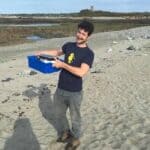-
Asked by anon-295444 on 21 Jun 2021.0
Question: Have you encountered any problems or anomalies with the sequencing that lead research in a different direction?
- Keywords:
-
Elena Arrigoni answered on 21 Jun 2021:
Hi Charlotte,
my team and I work with fungi at RBG Kew. Fungi can be incredibly different from each other: some are chunky mushrooms, some others look like leathery mats, others can come in tiny cup-like structures, stony-hard beads or could even have a powdery texture. We also culture many of the samples we receive in order to produce large quantities of mycelium, when possible (not all fungi can be cultured in the lab, though!). In addition, some fungi can produce chemical compounds that, if not eliminated, can inhibit downstream procedures, such as DNA extraction, PCR and sequencing. The preservation method is also crucial in ensuring the quality of the sample: fresh samples dipped in special preservative solutions are ideal for ensuring good DNA and good sequencing results. All these aspects represent a real challenge when trying to optimize a standard procedure in the lab, because it is really difficult to find a protocol that will work well for everything. And if we do not get good DNA, we will not get good sequencing results. To answer your question, we do encounter issues with the sequencing, and we generally tackle them by adjusting the lab protocols in order to extract good quality DNA, which is crucial for good quality sequencing. But do not get me wrong, fungal diversity is a treasure, not an issue: we just need to figure out the right protocol for the right group of fungi!
Related Questions
Latest Questions
-
What is the species you are most excited to investigate?
-
What’s the most interesting species you’ve studied?
-
What is the Devil’s Coach Horse’s closed relative?
-
What is everyone’s favourite bug?
-
What drew you the species that you study?
-
What A-Level results did you get?
-
Is this always what you wanted to do??
-
how does nitrogen and dry ice preserve dna ?
-
Have you seen any effects of climate change on the aquatic environment/ organisms?
-
do you actually like worms or do you just pretend? (i am terrified of worms)
Latest Comments
-
Do all butterflies migrate? Are they all as extreme as the monarch butterfly? (1 comment)
-
🍄🧬 Chicken of the Woods: Our first fungus genome (1 comment)
-
When did you leave your parents? (1 comment)
-
How long have you worked in the field you work in? (1 comment)
-
How do you ensure that your DNA samples haven't been contaminated? (2 comments)







Comments